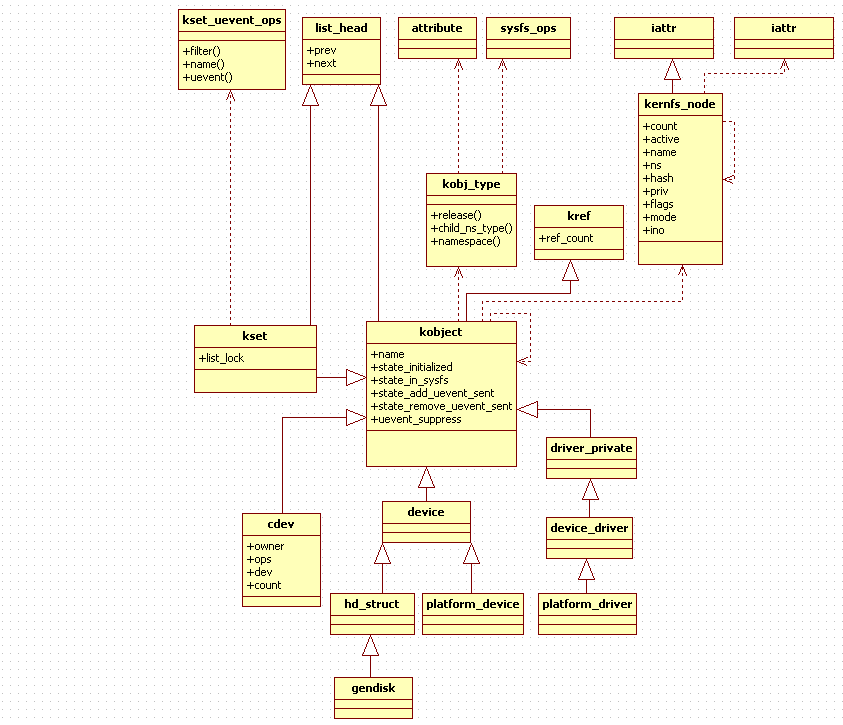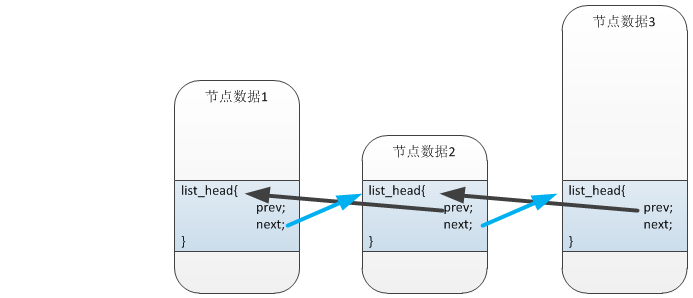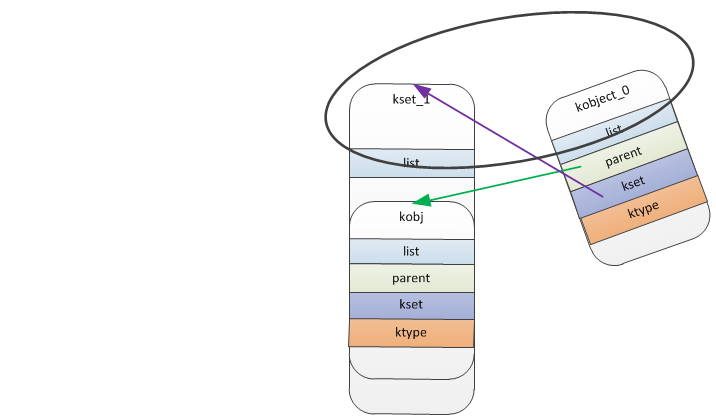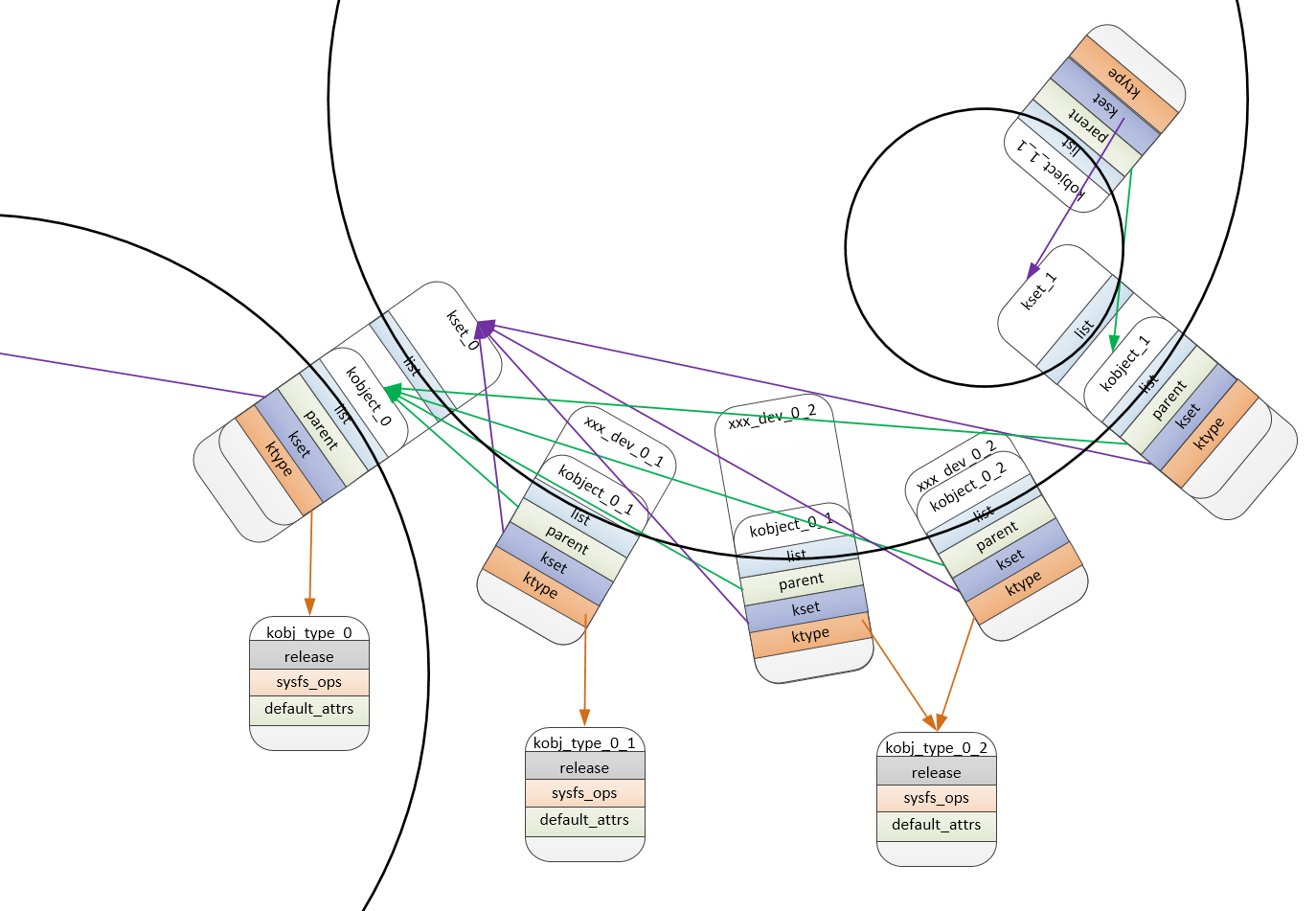Linux内核大量使用面向对象的设计思想,通过追踪源码,我们甚至可以使用面向对象语言常用的UML类图来分析Linux设备管理的"类"之间的关系。这里以4.8.5内核为例从kobject,kset,ktype的分析入手,进而一探内核对于设备的管理方式
container_of宏
这个宏几乎是linux数据结构的基础,Linux中的链表与传统的链表不同,其链表的节点本身并不包含任何数据,任何想要插入到链表的数据只需要包含一个事先写好的节点
//include/linux/types.h
184 struct list_head {
185 struct list_head *next, *prev;
186 };
但是,使用这种通用的链表的第一个问题就是如何根据一个list_head成员来找到相应的数据,Linux社区的大神们早就找到了相应的方法,就是利用下面这个container_of宏,只需要输入成员指针ptr,包含该成员的结构体类型type,以及该成员在结构体中名字name就可以返回包含ptr的type类型的结构首地址,这个宏充分利用了C语言直接操作内存的特性。需要注意的是,如果单纯为了得到地址只需要ptr-&((type* 0)->member),内核的写法其实还利用了编译器的类型检查机制做了一份校验工作,即如果传入的ptr类型和type->member的类型不匹配,会报错,
//include/linux/kernel.h
14 #define offsetof(TYPE, MEMBER) ((size_t) &((TYPE *)0)->MEMBER)
830 #define container_of(ptr, type, member) ({
831 const typeof( ((type *)0)->member ) *__mptr = (ptr);
832 (type *)( (char *)__mptr - offsetof(type,member) );})
kobject结构
Linux内核中有大量的驱动,而这些驱动往往具有类似的结构,根据面向对象的思想,我们就可以将这些共同的部分提取为父类,这个父类就是kobject,也就是驱动编程中使用的.ko文件的由来,下面这张图是我根据内核源码的kobject绘制的简单的UML图,从中可以看出,kobject包含了大量的设备必须的信息,而三大类设备驱动都需要包含这个kobject结构,也就是"继承"自kobject。一个kobject对象就对应sys目录中的一个设备。
内核源码中的kobject结构定义如下
//include/linux/kobject.h
63 struct kobject {
64 const char *name;
65 struct list_head entry;
66 struct kobject *parent;
67 struct kset *kset;
68 struct kobj_type *ktype;
69 struct kernfs_node *sd; /* sysfs directory entry */
70 struct kref kref;
71 #ifdef CONFIG_DEBUG_KOBJECT_RELEASE
72 struct delayed_work release;
73 #endif
74 unsigned int state_initialized:1;
75 unsigned int state_in_sysfs:1;
76 unsigned int state_add_uevent_sent:1;
77 unsigned int state_remove_uevent_sent:1;
78 unsigned int uevent_suppress:1;
79 };
这个结构中,
struct kobject
--64-->name表示kobject对象的名字,对应sysfs下的一个目录。
--65-->entry是kobject中插入的head_list结构,
--66-->parent是指向当前kobject父对象的指针,体现在sys结构中就是包含当前kobject对象的目录对象,
--67-->kset表示当前kobject对象所属的集合,
--68-->ktype表示当前kobject的类型。
--69-->sd用于表示VFS文件系统的目录项,是设备与文件之间的桥梁,sysfs中的符号链接就是通过kernfs_node内的联合体实现的。
--70-->kref是对kobject的引用计数,当引用计数为0时,就回调之前注册的release方法释放该对象。
--74-->state_initialized:1初始化标志位,在对象初始化时被置位,表示对象是否已经被初始化。
--75-->state_in_sysfs:1表示kobject对象在sysfs中的状态,在对应目录中被创建则置1,否则为0。
--76-->state_add_uevent_sent:1是添加设备的uevent事件是否发送标志,添加设备时会向用户空间发送uevent事件,请求新增设备。
--77-->state_remove_uevent_sent:1是删除设备的uevent事件是否发送标志,删除设备时会向用户空间发送uevent事件,请求卸载设备
kobject操作
4.8.5的内核在lib/koject.c等源码中定义了一系列对kobject操作的函数,这里只列出最简单的几个
初始化kobject
187 static void kobject_init_internal(struct kobject *kobj)
188 {
189 if (!kobj)
190 return;
191 kref_init(&kobj->kref);
192 INIT_LIST_HEAD(&kobj->entry);
193 kobj->state_in_sysfs = 0;
194 kobj->state_add_uevent_sent = 0;
195 kobj->state_remove_uevent_sent = 0;
196 kobj->state_initialized = 1;
197 }
325 void kobject_init(struct kobject *kobj, struct kobj_type *ktype)
326 {
327 char *err_str;
...
344 kobject_init_internal(kobj);
345 kobj->ktype = ktype;
346 return;
...
351 }
注册kobject
//添加kobject到内核
200 static int kobject_add_internal(struct kobject *kobj)
201 {
202 int error = 0;
203 struct kobject *parent;
...
214 parent = kobject_get(kobj->parent);
215
216 /* join kset if set, use it as parent if we do not already have one */
217 if (kobj->kset) {
218 if (!parent)
219 parent = kobject_get(&kobj->kset->kobj);
220 kobj_kset_join(kobj);
221 kobj->parent = parent;
222 }
223
224 pr_debug("kobject: '%s' (%p): %s: parent: '%s', set: '%s'
",
225 kobject_name(kobj), kobj, __func__,
226 parent ? kobject_name(parent) : "<NULL>",
227 kobj->kset ? kobject_name(&kobj->kset->kobj) : "<NULL>");
228
229 error = create_dir(kobj);
...
246 kobj->state_in_sysfs = 1;
247
248 return error;
249 }
354 static __printf(3, 0) int kobject_add_varg(struct kobject *kobj,
355 struct kobject *parent,
356 const char *fmt, va_list vargs)
357 {
358 int retval;
...
365 kobj->parent = parent;
366 return kobject_add_internal(kobj);
367 }
394 int kobject_add(struct kobject *kobj, struct kobject *parent,
395 const char *fmt, ...)
396 {
397 va_list args;
398 int retval;
...
410 va_start(args, fmt);
411 retval = kobject_add_varg(kobj, parent, fmt, args);
412 va_end(args);
413
414 return retval;
415 }
初始化并注册kobject
429 int kobject_init_and_add(struct kobject *kobj, struct kobj_type *ktype,
430 struct kobject *parent, const char *fmt, ...)
431 {
432 va_list args;
433 int retval;
434
435 kobject_init(kobj, ktype);
436
437 va_start(args, fmt);
438 retval = kobject_add_varg(kobj, parent, fmt, args);
439 va_end(args);
440
441 return retval;
442 }
注销kobject
569 void kobject_del(struct kobject *kobj)
570 {
571 struct kernfs_node *sd;
572
573 if (!kobj)
574 return;
575
576 sd = kobj->sd;
577 sysfs_remove_dir(kobj);
578 sysfs_put(sd);
579
580 kobj->state_in_sysfs = 0;
581 kobj_kset_leave(kobj);
582 kobject_put(kobj->parent);
583 kobj->parent = NULL;
584 }
kobject计数加一
//lib/kobject.c
591 struct kobject *kobject_get(struct kobject *kobj)
592 {
593 if (kobj) {
594 if (!kobj->state_initialized)
595 WARN(1, KERN_WARNING "kobject: '%s' (%p): is not "
596 "initialized, yet kobject_get() is being "
597 "called.
", kobject_name(kobj), kobj);
598 kref_get(&kobj->kref);
599 }
600 return kobj;
601 }
kobject计数减一
//将kobject对象的引用计数加1,同时返回该对象指针。
//include/linux/kref.h
40 static inline void kref_get(struct kref *kref)
41 {
42 /* If refcount was 0 before incrementing then we have a race
43 * condition when this kref is freeing by some other thread right now.
44 * In this case one should use kref_get_unless_zero()
45 */
46 WARN_ON_ONCE(atomic_inc_return(&kref->refcount) < 2);
47 }
//lib/kobject.c
591 struct kobject *kobject_get(struct kobject *kobj)
592 {
593 if (kobj) {
...
598 kref_get(&kobj->kref);
599 }
600 return kobj;
601 }
//将kobject对象的引用计数加1,如果减为零就释放
//include/linux/kref.h
67 static inline int kref_sub(struct kref *kref, unsigned int count,
68 void (*release)(struct kref *kref))
69 {
70 WARN_ON(release == NULL);
71
72 if (atomic_sub_and_test((int) count, &kref->refcount)) {
73 release(kref);
74 return 1;
75 }
76 return 0;
77 }
96 static inline int kref_put(struct kref *kref, void (*release)(struct kref *kref))
97 {
98 return kref_sub(kref, 1, release);
99 }
//lib/kobject.c
684 void kobject_put(struct kobject *kobj)
685 {
686 if (kobj) {
...
691 kref_put(&kobj->kref, kobject_release);
692 }
693 }
kset结构
kset表示一组kobject的集合,kobject通过kset组织成层次化的结构,所有属于该kset的kobjetc结构的parent指针指向kset包含的kobject对象,构成一个父子层次关系这些kobject可以是不同或相同的类型(kobj_type)。sysfs中的设备组织结构很大程度上都是根据kset进行组织的,比如"/sys/drivers"目录就是一个kset对象,包含系统中的驱动程序对应的目录,驱动程序的目录又kobject表示。比如在平台设备模型中,当我们注册一个设备或驱动到平台总线,其实是将对应的kobject挂接到platform总线的kset上,每种总线都是维护两条链表(两个kset),一条用于链接挂接在上面的驱动(驱动kset),一条用于链接挂接在上面的设备(设备kset)。
//include/linux/kobject.h
168 struct kset {
169 struct list_head list;
170 spinlock_t list_lock;
171 struct kobject kobj;
172 const struct kset_uevent_ops*uevent_ops;
173 };
下面简单分析一下其中的成员
struct kset
--169-->list_head还是那个用来挂在链表上的结构,包含在一个kset的所有kobject构成了一个双向循环链表,list_head就是这个链表的头部,这个链表用来连接第一个和最后一个kobject对象,第一个kobjetc使用entry连接kset集合以及第二个kobject对象,第二个kobject对象使用entry连接第一个kobject对象和第三个kobject对象,依次类推,最终形成一个kobject对象的链表
--171-->kobj(171)是归属于该kset的所有的kobject的共有parent,这个parent就是体现内核设备组织结构的关键,同时,kset的引用计数就是内嵌的kobject对象的引用次数。
kset操作
下面是几个关于kset的基础操作方法
初始化kset
//lib/kobject.c
187 static void kobject_init_internal(struct kobject *kobj)
188 {
189 if (!kobj)
190 return;
191 kref_init(&kobj->kref);
192 INIT_LIST_HEAD(&kobj->entry);
193 kobj->state_in_sysfs = 0;
194 kobj->state_add_uevent_sent = 0;
195 kobj->state_remove_uevent_sent = 0;
196 kobj->state_initialized = 1;
197 }
767 void kset_init(struct kset *k)
768 {
769 kobject_init_internal(&k->kobj);
770 INIT_LIST_HEAD(&k->list);
771 spin_lock_init(&k->list_lock);
772 }
注册kset
//lib/kobject.c
809 int kset_register(struct kset *k)
810 {
811 int err;
812
813 if (!k)
814 return -EINVAL;
815
816 kset_init(k);
817 err = kobject_add_internal(&k->kobj);
818 if (err)
819 return err;
820 kobject_uevent(&k->kobj, KOBJ_ADD);
821 return 0;
822 }
注销kset
//lib/kobject.c
829 void kset_unregister(struct kset *k)
830 {
831 if (!k)
832 return;
833 kobject_del(&k->kobj);
834 kobject_put(&k->kobj);
835 }
kset计数加一
//include/linux/kobject.h
187 static inline struct kset *kset_get(struct kset *k)
188 {
189 return k ? to_kset(kobject_get(&k->kobj)) : NULL;
190 }
kset计数减一
192 static inline void kset_put(struct kset *k)
193 {
194 kobject_put(&k->kobj);
195 }
kobj_type结构
//include/linux/kobject.h
116 struct kobj_type {
117 void (*release)(struct kobject *kobj);
118 const struct sysfs_ops *sysfs_ops;
119 struct attribute **default_attrs;
120 const struct kobj_ns_type_operations *(*child_ns_type)(struct kobject *kobj);
121 const void *(*namespace)(struct kobject *kobj);
122 };
这个结构主要是表征kobject的类型,
struct ktype
--117-->release是一个释放kobject对象的接口,有点像面向对象中的析构。
--118-->sysfs_ops是操作kobject的方法集,
//include/linux/sysfs.h
29 struct attribute {
30 const char *name;
31 umode_t mode;
32 #ifdef CONFIG_DEBUG_LOCK_ALLOC
33 bool ignore_lockdep:1;
34 struct lock_class_key *key;
35 struct lock_class_key skey;
36 #endif
37 };
209 struct sysfs_ops {
210 ssize_t (*show)(struct kobject *, struct attribute *, char *);
211 ssize_t (*store)(struct kobject *, struct attribute *, const char *, si
212 };
struct sysfs_ops
--210-->我们在使用cat echo等工具(read()/write()系统调用)进行读写sysfs中相应驱动的属性时,其实就是回调驱动的show()和store()。由此可见,对同一类型的kobject操作会回调同一个kobj_type的方法
//include/linux/kobject.h
197 static inline struct kobj_type *get_ktype(struct kobject *kobj)
198 {
199 return kobj->ktype;
200 }
从这个函数中可以看出,4.8.5提取kobject的kobj_type的时候直接提取kobject的,我还测试过3.14版本的,也是这种写法,不过网上还有下面的这种get_ktype的实现,还没找到具体是哪个版本,显然,这个版本中kset中的ktype这个类型优先于 kobject 自身中的 ktype 。因此在典型的应用中, 在 struct kobject 中的 ktype 成员被设为 NULL, 而 kset 中的ktype是实际被使用的。
static inline struct kobj_type * get_ktype(struct kobject * k)
{
if (k->kset && k->kset->ktype)
return k->kset->ktype;
else
return k->ktype;
}
结构框图
kobject,kset是Linux设备管理中的基本结构体,但在实际操作中我们几乎不会实际操作这些结构,因为他们本身并不具有针对某一个具体设备或驱动的信息,在Linux内核中,这两个结构都是被包含具体的设备结构中,比如cdev,gendisk等,从面向对象的角度考虑,就是每一类设备都可以看作这两个结构的子类。
通过上面的分析,我们可以看出这三者之间的关系,并画出下面的结构框图,sysfs中的上目录结构就是根据kset之间的数据组织方式进行呈现的。



